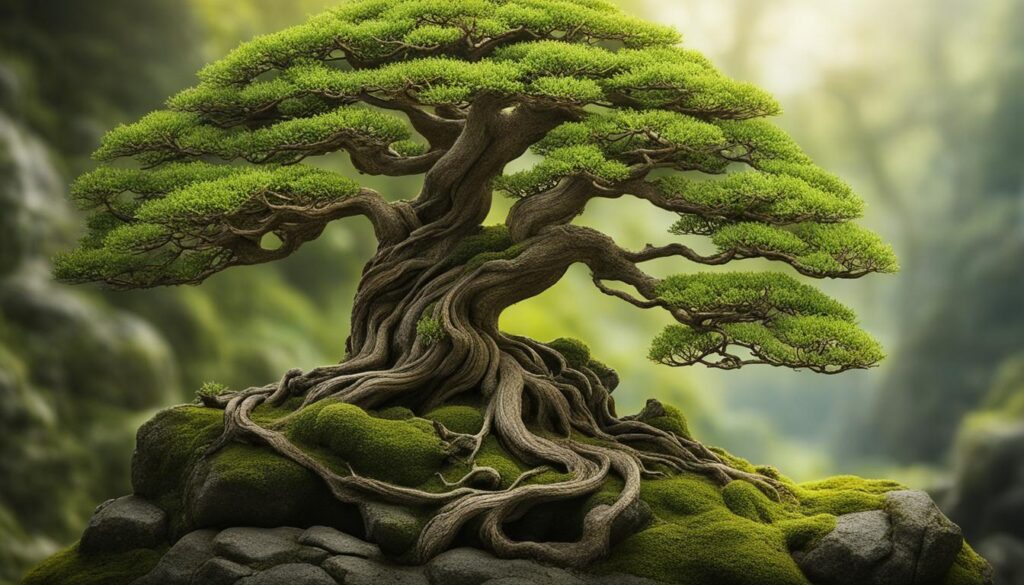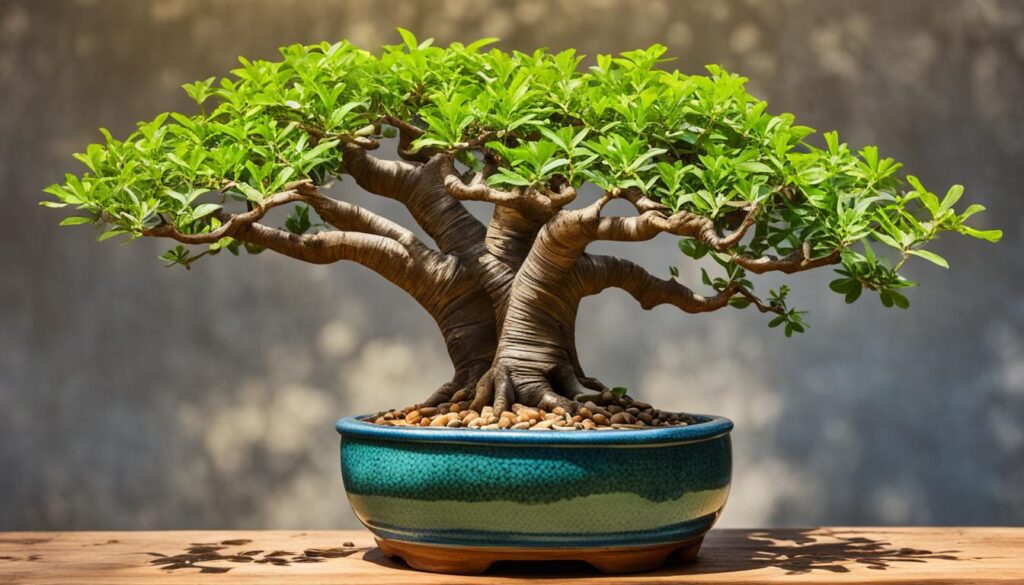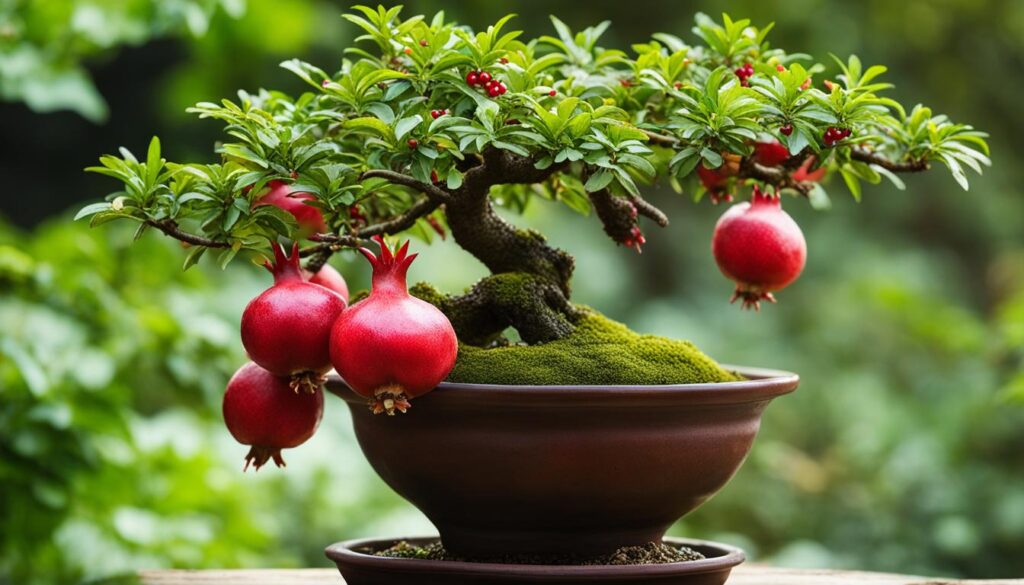What is Bonsai
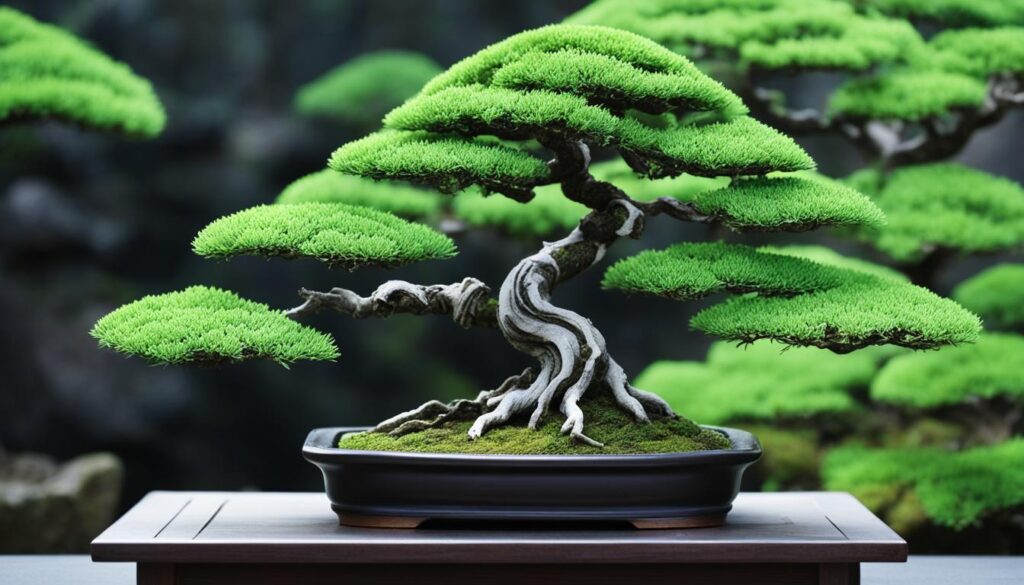
Bonsai is the art of growing and shaping trees in pots to create small landscapes. This practice started in China over 2,300 years ago and became popular in Japan among Zen Buddhists. The word “bonsai” means “tray planting” in Japanese, emphasizing the use of shallow containers to keep trees small.
Bonsai trees are small and have pruned branches and roots. Artists shape these trees to mimic larger trees while showing their natural beauty. The small size offers a unique view of nature’s resilience, making bonsai an appealing art form.
Characteristics and Traits
Growing bonsai requires attention to its unique features. Key traits include:
- Small size: Regular pruning and root management keep bonsai trees small and in harmony with nature.
- Elegance: Bonsai trees exhibit a refined look, capturing the beauty of full-sized trees.
- Patience and discipline: Caring for bonsai requires knowledge and fosters a deep connection with nature.
- Aging and maturity: Bonsai trees display aging traits like gnarled trunks, adding character.
Types of Trees Suitable for Bonsai
Many tree species are suitable for bonsai, each with unique traits. Popular types include:
| Tree Species | Characteristics | Suitable Climate |
|---|---|---|
| Junipers | Evergreen leaves, strong and adaptable. | Moderate to cool climates. |
| Maples | Vibrant leaves, attractive branching. | Temperate climates. |
| Pines | Long needles, rugged look. | Various climates and species-dependent. |
| Cherry and Plum | Fruit-bearing, fragrant flowers. | Moderate to warm climates. |
History and Origin of Bonsai
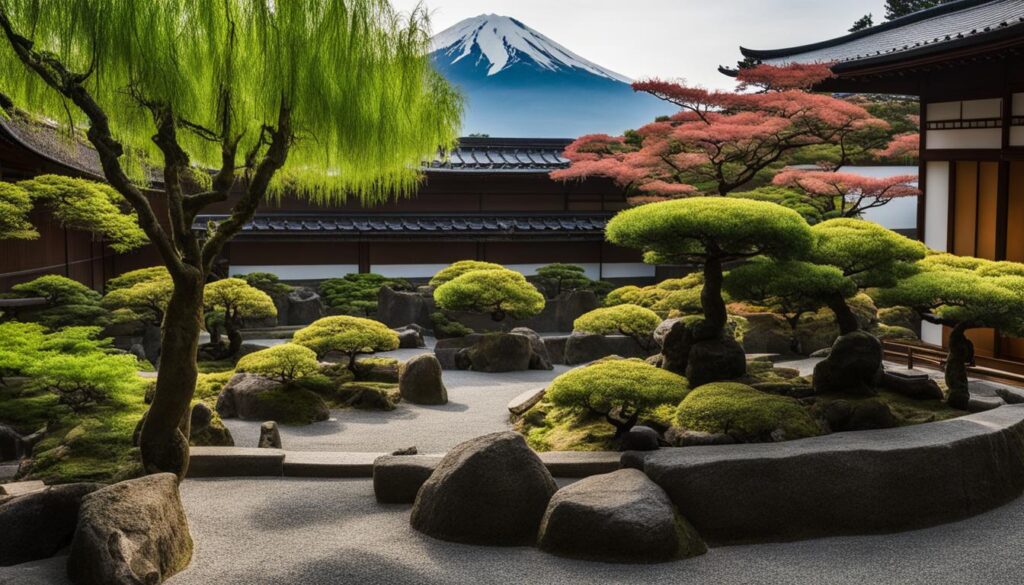
Bonsai has a rich history of over 2,300 years. It began in ancient China as “pun-jai,” practiced by aristocrats. These miniature trees were symbols of prestige and wealth.
In Japan, bonsai flourished as an art form during the Edo period. Zen Buddhists adopted bonsai as part of their meditative practices. The detailed care for these trees inspired tranquility and contemplation.
Bonsai culture expanded in Japan as commoners embraced it. Scholarly books on techniques and large exhibitions captivated audiences with the beauty of these miniature trees.
Today, bonsai is integral to Japanese culture and recognized worldwide as a symbol of Japanese aesthetics, inspiring many to explore this art form.
How old do bonsai trees live
Bonsai trees can live for decades, some ranging from 40 to over 1,000 years, based on species and care. Junipers typically live for 50-70 years, while Ficus and Pine bonsai can reach 100-200 years or more.
Must read: 7 Oldest Bonsai Trees In The World
Cultural Significance of Bonsai
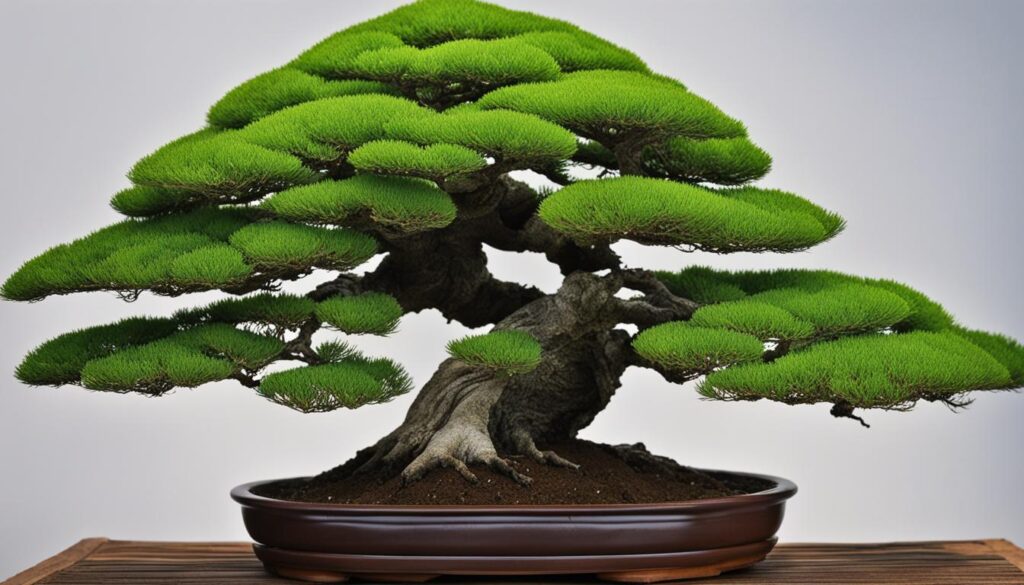
Bonsai holds great cultural significance in Japan. It expresses respect for nature and is an art form that requires patience and skill.
Bonsai trees are displayed in special tokonoma alcoves in homes, admired for their beauty and symbolism. The craftsmanship reflects the attention to detail valued in Japanese culture.
Bonsai symbolizes harmony, balance, and the beauty of life. Caring for bonsai encourages mindfulness and a connection with nature.
Bonsai has captivated not only Japan but has gained recognition globally as a symbol of Japanese culture. Exhibitions attract enthusiasts worldwide, showcasing intricate designs and mastery of bonsai techniques.
“The art of bonsai is more than simply cultivating trees; it is about capturing the essence of nature and creating a harmonious balance between the tree and its surroundings.”
The cultural significance of bonsai transcends borders, inspiring appreciation for nature’s beauty and artistry in creating living sculptures.
How big does a bonsai tree grow
Bonsai trees can grow up to 80 inches.
Bonsai trees vary significantly in size based on species and cultivation techniques. They can range from as small as 1-3 inches (2-8 cm) to 60-80 inches (152-203 cm) when fully grown. Size classifications include:
- Imperial bonsai: 60-80 inches (152-203 cm)
- Hachi-uye: 40-60 inches (102-152 cm)
- Dai or Omono: 30-48 inches (76-122 cm)
- Chiu or Chumono: 16-36 inches (41-91 cm)
- Katade-mochi: 10-18 inches (25-46 cm)
- Komono: 6-10 inches (15-25 cm)
- Shohin: 5-8 inches (13-20 cm)
- Mame: 2-6 inches (5-15 cm)
- Shito: 2-4 inches (5-10 cm)
- Size: 1-3 inches (3-8 cm)
The final size of a bonsai tree depends on several factors, including pot type and care, like pruning and watering. If planted in the ground, a bonsai tree can grow into a full-sized tree due to unrestricted growth.
Bonsai Techniques and Care
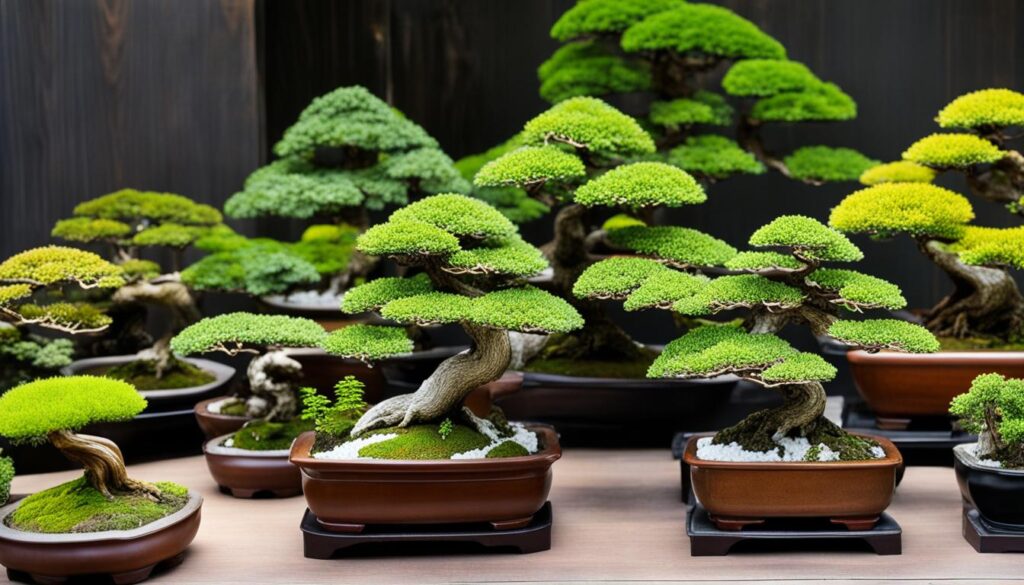
Proper care and techniques are essential for bonsai health. Key aspects include soil, watering, pruning, wiring, and repotting.
Soil Used for Bonsai
Bonsai soil provides nutrients and aeration for roots. It should drain well to prevent waterlogged roots while retaining moisture. A common bonsai soil mix includes Akadama (clay), organic matter like compost, and inorganic substances like pumice or lava rock for optimal drainage and moisture retention.
Watering
Proper watering is vital for bonsai health. The frequency depends on tree species, container size, climate, and season. Water bonsai when the top layer of soil feels slightly dry. Ensure thorough watering without overdoing it to avoid root rot. Adjust the watering schedule based on soil moisture levels for optimal hydration.
Pruning and Wiring
Pruning and wiring are essential techniques for shaping bonsai trees. Pruning involves cutting back branches to promote growth and balance. Wiring helps guide branch growth into desired shapes. Use proper tools like bonsai shears and wire cutters to ensure clean cuts and minimize harm to the tree.
Repotting
Repotting is necessary every few years to refresh soil, prevent root binding, and promote healthy growth. Repot during early spring when trees are dormant or late winter before new growth starts. Remove the tree from its container, prune roots, and place it in fresh bonsai soil to renew nutrients and support a healthy root system.
| Bonsai Care Technique | Description |
|---|---|
| Soil Used for Bonsai | Well-draining soil that retains moisture |
| Watering | Proper hydration based on tree species and environment |
| Pruning and Wiring | Shaping and maintaining the desired form of the bonsai |
| Repotting | Refreshing soil and promoting healthy root growth |
Special Requirements for Bonsai Trees
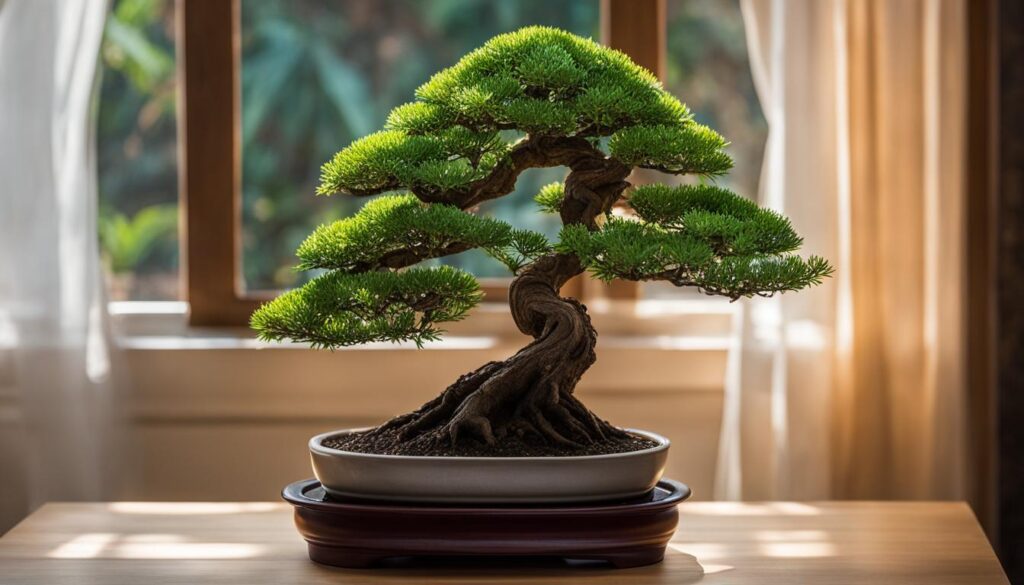
Bonsai trees have unique needs and require specific conditions to thrive. Understanding these requirements will help ensure their health and longevity. Important factors include sunlight, temperature, humidity, fertilization, and pest control.
Sunlight: Bonsai trees need a mix of sunlight and shade. Some prefer full sun, while others need partial shade. Knowing your tree species’ sunlight needs is essential for optimal growth.
Temperature: Different species have different temperature preferences. Some thrive in warmth, while others prefer cooler conditions. Providing the right temperature range is crucial for a bonsai tree’s well-being.
Humidity: Bonsai trees vary in humidity needs. Some prefer high humidity, while others tolerate drier conditions. Understanding your bonsai’s humidity requirements helps create the ideal environment.
Fertilization: Regular fertilization is important for providing nutrients. Use a balanced fertilizer designed for bonsai trees according to application guidelines.
Pest Control: Bonsai trees are susceptible to pests and diseases. Regular inspections for signs of problems and taking preventive measures is essential. Good hygiene and care help protect your bonsai from harmful pests.
Meeting these special requirements will create an optimal environment for bonsai trees, contributing to their beauty and longevity. Proper sunlight, temperature, humidity, fertilization, and pest control are key to their health.
Indoor vs. Outdoor Bonsai Trees
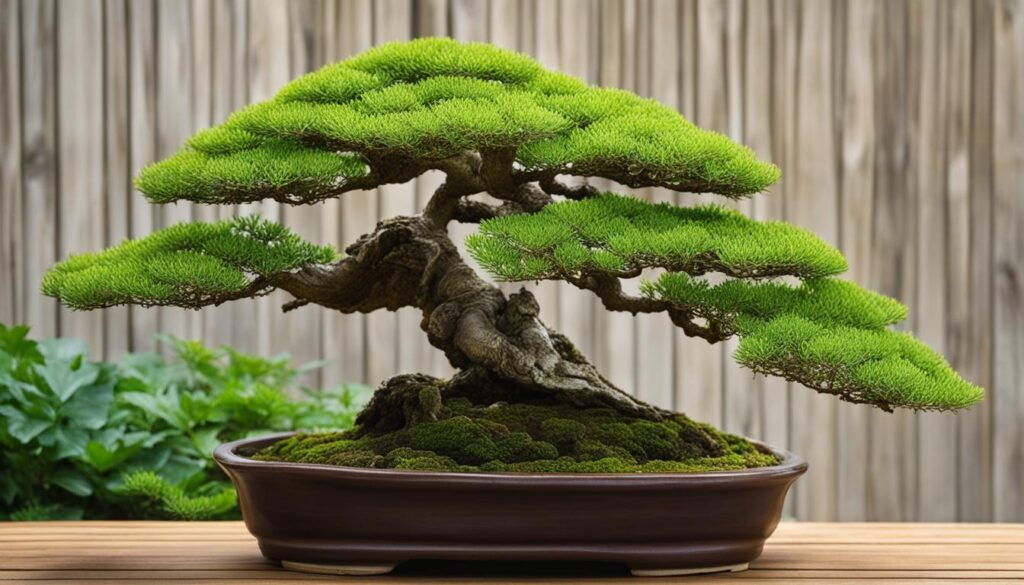
Bonsai trees can be indoors or outdoors, each with different requirements for care. Understanding these differences is important for their survival.
Indoor bonsai trees should be near a window with sufficient sunlight or supplemented with grow lights for photosynthesis. Different species have varying light needs, so choose the right tree for your indoor setting.
Indoor bonsai trees also need higher humidity than outdoor trees. Place a tray with water nearby or use a humidifier to prevent drying and promote healthy growth.
Protection from extreme temperatures is essential for indoor bonsai trees. Avoid drafty windows or areas with temperature fluctuations to maintain stable conditions.
Outdoor bonsai trees should be chosen based on local climate and placed in well-lit areas with suitable sun exposure. Some thrive in full sun, while others prefer partial shade. Consider the climate to select trees that can endure outdoor conditions.
Outdoor bonsai trees benefit from natural airflow, which strengthens branches and prevents fungal diseases. Position them where air circulates well for optimal health.
Bonsai Styles
Bonsai trees provide endless artistic possibilities. There are two main categories of bonsai styles: traditional and modern. These styles highlight the diverse techniques and interpretations that enthusiasts can use to create unique miniature landscapes.
Traditional Styles
The traditional bonsai styles reflect centuries-old Japanese aesthetics, aiming to recreate natural tree growth patterns in miniature. These include:
- Chokkan (Formal Upright): This style features a straight trunk with branches decreasing in size toward the top.
- Shakan (Slanting): The trunk has a distinct slant, resembling a tree on a hillside.
- Moyogi (Informal Upright): Moyogi trees have curving trunks that add movement and elegance.
- Fukinagashi (Windblown): This style depicts the effect of strong winds, with branches leaning to one side.
- Kengai (Cascade): Kengai bonsai have a cascading trunk, resembling a tree growing on a cliff.
These traditional styles require careful maintenance and precise pruning to capture nature’s essence in miniature.
Modern Styles
Modern bonsai styles allow for more abstract interpretations and creative expression. This experimental approach lets enthusiasts push traditional boundaries and create unique compositions.
Modern styles include:
- Ikadabuki (Layered Branching): This style emphasizes layered branches and foliage for complexity.
- Bunjin (Literati): Bunjin bonsai show an unconventional, windswept look with elegant, elongated trunks.
- Neagari (Exposed Roots): Neagari bonsai feature visible root systems, adding dynamic elements.
- Shitate (Raft): Shitate bonsai depict a tree growing horizontally, resembling driftwood.
- Kubinagashi (Head Hanging): Kubinagashi bonsai have a distinct trunk bend for movement and individuality.
These modern styles encourage bonsai artists to explore innovative methods and express their artistic vision.
Common Mistakes and Challenges While Growing a Bonsai
Growing bonsai can be rewarding but also challenging, especially for beginners. Awareness of common mistakes and challenges is important for the health of your bonsai.
One common mistake is over or under watering. Both can harm the tree. Water your bonsai regularly, allowing the soil to dry slightly between sessions.
Improper pruning can also affect growth and form. Understand specific pruning techniques for your species and prune at the right times to encourage growth. Using the wrong soil can hinder root development. Ensure you use well-draining soil specifically for bonsai.
While caring for your bonsai, challenges like pests, diseases, and root issues may arise. Being vigilant helps identify and address problems quickly. Inspect your tree regularly for pests or diseases and take preventive measures like using insecticidal soap or consulting a professional if needed. Monitor roots to prevent issues like root rot from overwatering or poor drainage.
By being attentive to your bonsai’s needs, you can avoid common mistakes and overcome challenges. Provide proper care, including regular watering, appropriate pruning, and suitable soil. Stay vigilant in monitoring health and act promptly if issues arise. With patience and dedication, you can enjoy the beauty of your bonsai.
Unleash Your Inner Zen: The Ultimate Beginners Guide to Mastering Bonsai Tree Care! >>>
Unlock the Secrets to Thriving Orange Tree Bonsai: The Ultimate Care and Growing Guide! >>>
Unlock the Secrets to Perfectly Caring for Every Ficus Bonsai Species! >>>

